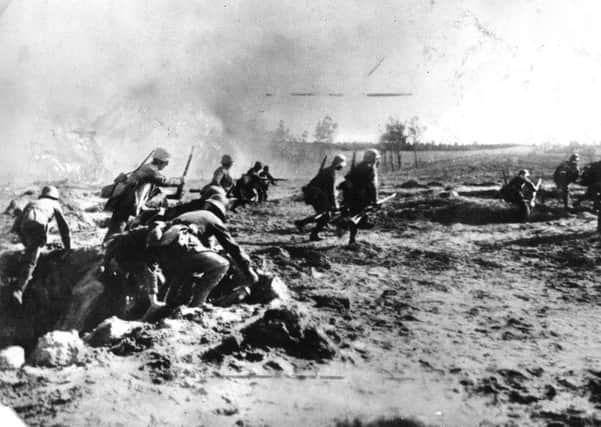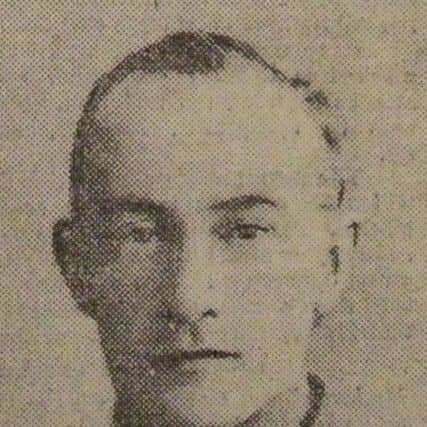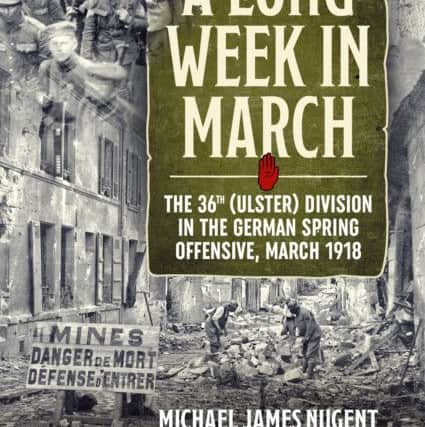New book tells of remarkable bravery of 36th Ulster Division beyond the Somme


This March will mark 101 years since a battle which almost saw the annihilation of the 36th (Ulster) Division as they bore the brunt of the German Spring Offensive.
As the division held the front line near the French town of Saint Quentin, it suffered even greater casualties than they did at the Somme.
Advertisement
Hide AdAdvertisement
Hide AdA new book by Coleraine man Michael Nugent aims to tell the story of one of WWI’s lesser celebrated battles in the context of the heroic actions of the 36th Division in what was initially deemed a German victory.


Michael, who is a director of The Military Heritage of Ireland Trust and Manager of WWI Research Ireland, gained his information from a number of military sources and also got his hands on some German regimental history relating to the 1918 Spring Offensive.
He said: “For most people in Ulster and Northern Ireland the First World War is the Somme. That’s it.
“But there was a battle in 1918 where the Ulster Division suffered more casualties than the Somme.
Advertisement
Hide AdAdvertisement
Hide Ad“The only existing comprehensive account of this from a local perspective comes in Cyril Fall’s iconic book The History of the 36th Ulster Division which was published in 1922.


“People know all about the Somme, but very little is known about the exceptional bravery of the 36th Ulster Division in this battle (around Saint Quentin).”
Michael examines the factors beyond the control of those in the 36th Division which led to them holding the front line opposite the northern French town of St Quentin on the morning of March 21, 1918 at the beginning of the German Spring Offensive or Kaiserschlacht (Kaiser’s Battle).
The opening day of the battle is scrutinised in detail, with the experiences of each of the infantry battalions forming the division being analysed.
Advertisement
Hide AdAdvertisement
Hide AdThe actions leading to the award of the two Victoria Crosses won by the division in the last week of March are investigated, with new information being made available.


Each day of the withdrawal is examined with important events being analysed in detail by Michael.
Michael said: “The 1st Battalion of the Royal Inniskilling Fusiliers on March 22 fought to the last man against the German Prussian guard divisions who were the elite of the German Army.
“On March 24 the 2nd Battalion of Royal Irish Rifles fought until they had no ammunition left then fixed bayonets and charged the Germans. They had 96 men killed.
Advertisement
Hide AdAdvertisement
Hide Ad“The 9th Royal Irish Fusiliers on the same day, they held the entire front so the division was able to retreat.
“On the same day there was a cavalry charge which saved the day for the division. What had been an organised withdrawal was in danger of turning into a rout. I’ve spine tingling accounts from cavalrymen who took part in it.”
A chapter of the book is devoted to the analysis of casualty figures while the varied experiences of those taken prisoner is also examined using personal accounts.
Michael said: “Ultimately the book proves that although under severe pressure, the Ulster Division with typical obstinacy, bent, but never broke and emerged in a position to play a full part in the final drive to the Armistice.
Advertisement
Hide AdAdvertisement
Hide Ad“They were withdrawn at the end of March and taken to the French coast to reorganise. By April 8 they had been made up with reinforcements and sent to Ypres to face the second part of the German offensive.”
One of the unique aspects of Michael’s research comes from the regimental history of the German attackers who were facing the 36th Ulster Division: “I obtained the regimental history from the German infantry regiment 463. It’s written in old gothic German text. I got an exceptional German student who was able to translate the relevant passages for me.
“It was amazing that some of the German accounts match exactly the accounts of the 36th Ulster Division.
“I also got a very gifted graphic designer who, with permission, was able to redraw the maps from Fall’s 1922 book.”
Advertisement
Hide AdAdvertisement
Hide AdHe added: “There are lots of fascinating stories of exceptional bravery in the face of overwhelming odds.
“The reason I think there hasn’t been so much written about this battle and it has remained hidden is because it was probably perceived as a defeat.”
Despite the fact that the 36th Ulster Division suffered more casualties at Saint Quentin than the Somme, it is the latter battle which is synonymous with the division’s history.
Michael said: “The Battle of the Somme is very much tied in with unionist culture. You had Sir Edward Carson promising that Ulster would assist in the war effort. The 36th Ulster Division was one of Kitchener’s New Army divisions.
Advertisement
Hide AdAdvertisement
Hide Ad“The division came mainly from the Ulster Volunteer Force (formed in 1912 to block Home Rule for Ireland).
“They came from UVF units from the various counties en masse. They enlisted together, they fought together, they died together. The fatalities on the first day of the Somme had a disproportionate effect on small towns and villages throughout Ulster.”
It is estimated that total casualties (dead, wounded and missing) for the 36th division during the Battle of the Somme on July 1, 1916 totalled 5,500. Estimates for the division’s casualties during the German Spring Offensive in March 1918 range between an upper figure of 7,310 and a revised figure of 6,109.
Michael said that another difference between the division in 1916 and 1918 was that the division made up of volunteers from Ulster had been “diluted” with professional soldiers traditionally recruited from across Ireland and those transferred from mainly English Regiments.
Advertisement
Hide AdAdvertisement
Hide AdDiscussing why the 1918 Spring Offensive is not as widely reported as other WWI battles, Michael said: “We’d been at war for four years at this stage. Any optimism people had was started to wane.
“There was pacificism and communism going around Europe. People were basically fed up with the war. They wanted it to end.
“This German offensive was a big shock to the system. It was perceived at the time as a defeat for British troops. I think that had a big impact on public consciousness and I think that’smaybe why it hasn’t been widely reported.
“During my research I’ve found cases of exceptional bravery from individuals and collectively in small units of the 36th Ulster Division. I believe these amazing stories need to be told.”
Advertisement
Hide AdAdvertisement
Hide AdIn his book, Michael James Nugent focuses on the bravery of the 36th Ulster Division when faced with the German Spring Offensive.
Discussing the positioning of the division in northern France ahead of the German advance, Michael writes: “As luck would have it, the 36th (Ulster) Division were positioned in the middle of the new stretch of line, nearly opposite the historic town of St Quentin.
“This position, to the south of St Quentin saw the Ulster Division positioned straddling the River Somme and the St Quentin Canal.
“The Somme and the St Quentin canal ran parallel to each other from north to south until they joined near the hamlet of Le Hamel and the ground between was marshy. Hardly ideal defensively, the majority of the ground held by the Division was on the eastern side of the canal, with a small portion of the 109th Brigade area on the western side.
Advertisement
Hide AdAdvertisement
Hide Ad“The canal as it ran south through the Ulster Division territory had a number of small hamlets, each with a bridge connecting the eastern and western banks.”
When the German attack came and the order was given to retreat it was the responsibility of the battalions in the forward zone to hold the front line.
Among those standing their ground to aid the retreat was Edmund De Wind from Comber, a 34-year-old second lieutenant in the 15th Battalion, Royal Irish Rifles.
He was awarded the VC for his role during the German Spring Offensive on March 21, 1918, a day which he did not live to see the end of.
Advertisement
Hide AdAdvertisement
Hide AdOf De Wind’s honour, the London Gazette wrote on May 13, 1919: “For most conspicuous bravery and self-sacrifice on the 21st March, 1918, at the Race Course Redoubt, near Grugies. For seven hours he held this most important post, and though twice wounded and practically single-handed, he maintained his position until another section could be got to his help. On two occasions, with two NCO’s only, he got out on top under heavy machine gun and rifle fire, and cleared the enemy out of the trench, killing many. He continued to repel attack after attack until he was mortally wounded and collapsed. His valour, self-sacrifice and example were of the highest order.”
A Long Week in March is Michael’s second book.
In 2015 the 59-year-old retired father-of-two published another WWI-related book about the Battle of Festubert.
He said: “About five years ago I started researching my family. I had two great uncles from Percy Street, Belfast who went away to the Great War and never came back.
“One of them was called James. He was killed when he was 17 at a place called Festubert. I started looking into this and rapidly abandoned the family angle and concentrated on this battle.
Advertisement
Hide AdAdvertisement
Hide Ad“Very little was written about the Battle of Festubert (May 15-27 1915). The 2nd Battalion Royal Inniskilling Fusiliers had 264 men killed in the two days they were involved – most in the first half hour. I wrote a book from their perspective called It Was An Awful Sunday. I got it published in 2015 to coincide with the centenary.”
Michael also operates a business, drawing on his research skills to track down servicemen who fought in the Great War: “Sometimes I’m able to work it out down to the exact trenchline where they were killed.”